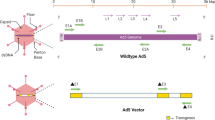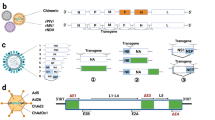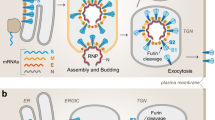Abstract
Establishing the effective use of ‘naked’ nucleic acids as vaccines would undoubtedly be one of the most important advances in the history of vaccinology. While nucleic acids show much promise for use as vaccine vectors in experimental animals, not a single naked nucleic acid vector has been approved for use in humans. Indeed, data from human clinical trials is scant: nucleic acid vaccines have not been clearly demonstrated to have any convincing efficacy in the prevention or treatment of infectious disease or cancer. Here we illustrate possible mechanisms underlying effective nucleic acid vaccination. We focus on progress that has been made in the improvement of their function. Additionally, we identify promising new strategies and try to forecast future developments that could lead to the real success of nucleic acid vaccines in the prevention and treatment of human disease.
This is a preview of subscription content, access via your institution
Access options
Subscribe to this journal
Receive 12 print issues and online access
$259.00 per year
only $21.58 per issue
Buy this article
- Purchase on Springer Link
- Instant access to full article PDF
Prices may be subject to local taxes which are calculated during checkout
Similar content being viewed by others
References
Tang DC, DeVit M, Johnston SA . Genetic immunization is a simple method for eliciting an immune response Nature 1992 356: 152–154
Ulmer JB et al. Heterologous protection against influenza by injection of DNA encoding a viral protein Science 1993 259: 1745–1749
Davis HL, Whalen RG, Demeneix BA . Direct gene transfer into skeletal muscle in vivo: factors affecting efficiency of transfer and stability of expression Hum Gene Ther 1993 4: 151–159
Corr M et al. Gene vaccination with naked plasmid DNA: mechanism of CTL priming J Exp Med 1996 184: 1555–1560
Doe B et al. Induction of cytotoxic T lymphocytes by intramuscular immunization with plasmid DNA is facilitated by bone marrow-derived cells Proc Natl Acad Sci USA 1996 93: 8578–8583
Iwasaki A et al. The dominant role of bone marrow-derived cells in CTL induction following plasmid DNA immunization atdifferent sites J Immunol 1997 159: 11–14
Bronte V et al. Antigen expression by dendritic cells correlates with the therapeutic effectiveness of a model recombinant poxvirus tumor vaccine Proc Natl Acad Sci USA 1997 94: 3183–3188
Condon C et al. DNA-based immunization by in vivo transfection of dendritic cells Nature Med 1996 2: 1122–1128
Porgador A et al. Predominant role for directly transfected dendritic cells in antigen presentation to CD8+ T cells after gene gun immunization J Exp Med 1998 188: 1075–1082
Matzinger P . An innate sense of danger Semin Immunol 1998 10: 399–415
Leitner WW, Ying H, Restifo NP . Enhancement of tumor specific immune response with plasmid DNA replicon vectors Cancer Res 2000 (in press)
Ying H et al. Cancer therapy using a self-replicating RNAvaccine Nature Med 1999 5: 823–827
Chen Y et al. DNA vaccines encoding full-length or truncated Neu induce protective immunity against Neu-expressing mammary tumors Cancer Res 1998 58: 1965–1971
Minev BR et al. Insertion signal sequence fused to minimal peptides elicits specific CD8+ T cell responses and prolongs survival of thymoma-bearing mice Cancer Res 1994 54: 4155–4161
Restifo NP et al. Antigen processing in vivo and the elicitation of primary CTL responses J Immunol 1995 154: 4414–4422
Fu TM et al. Protective cellular immunity: cytotoxic T-lymphocyte responses against dominant and recessive epitopes of influenza virus nucleoprotein induced by DNA immunization J Virol 1997 71: 2715–2721
Ciernik IF, Berzofsky JA, Carbone DP . Induction of cytotoxic T lymphocytes and antitumor immunity with DNA vaccines expressing single T cell epitopes J Immunol 1996 156: 2369–2375
Restifo NP . The new vaccines: building viruses that elicit antitumor immunity Curr Opin Immunol 1996 8: 658–663
Irvine KR et al. Cytokine enhancement of DNA immunization leads to effective treatment of established pulmonary metastases J Immunol 1996 156: 238–245
Bronte V et al. IL-2 enhances the function of recombinant poxvirus-based vaccines in the treatment of established pulmonary metastases J Immunol 1995 154: 5282–5292
Xiang Z, Ertl HC . Manipulation of the immune response to a plasmid-encoded viral antigen by coinoculation with plasmids expressing cytokines Immunity 1995 2: 129–135
Conry RM et al. Selected strategies to augment polynucleotide immunization Gene Therapy 1996 3: 67–74
Huang AY et al. Does B7-1 expression confer antigen-presenting cell capacity to tumors in vivo? J Exp Med 1996 183: 769–776
Biragyn A et al. Genetic fusion of chemokines to a self tumor antigen induces protective, T-cell dependent antitumor immunity Nat Biotechnol 1999 17: 253–258
Ellis JR et al. The association of an HPV16 oncogene variant with HLA-B7 has implications for vaccine design in cervical cancer Nature Med 1995 1: 464–470
Krieg AM . Lymphocyte activation by CpG dinucleotide motifs in prokaryotic DNA Trends Microbiol 1996 4: 73–76
Krieg AM et al. The role of CpG dinucleotides in DNA vaccines Trends Microbiol 1998 6: 23–27
Weiner GJ et al. Immunostimulatory oligodeoxynucleotides containing the CpG motif are effective as immune adjuvants in tumor antigen immunization Ppoc Natl Acad Sci USA 1997 94: 10833–10837
Leitner WW, Ying H, Restifo NP . DNA and RNA-based vaccines: principles, progress and prospects Vaccine 1999 18: 765–777
Yeung MC, Liu J, Lau AS . An essential role for the interferon-inducible, double-stranded RNA-activated protein kinase PKR in the tumor necrosis factor-induced apoptosis in U937 cells Proc Natl Acad Sci USA 1996 93: 12451–12455
Castelli JC et al. A study of the interferon antiviral mechanism: apoptosis activation by the 2–5A system J Exp Med 1997 186: 967–972
Berglund P et al. Enhancing immune responses using suicidal DNA vaccines Nat Biotechnol 1998 16: 562–565
Author information
Authors and Affiliations
Rights and permissions
About this article
Cite this article
Restifo, N., Ying, H., Hwang, L. et al. The promise of nucleic acid vaccines. Gene Ther 7, 89–92 (2000). https://doi.org/10.1038/sj.gt.3301117
Published:
Issue Date:
DOI: https://doi.org/10.1038/sj.gt.3301117
Keywords
This article is cited by
-
A review on the recent advances and application of vaccines against fish pathogens in aquaculture
Aquaculture International (2022)
-
Development of vaccine formulations: past, present, and future
Drug Delivery and Translational Research (2021)
-
Spherical Nucleic Acid Nanoparticles: Therapeutic Potential
BioDrugs (2018)
-
Vaccination with liposome–DNA complexes elicits enhanced antitumor immunity
Cancer Gene Therapy (2006)
-
Immunotherapy for Lymphomas
International Journal of Hematology (2003)



